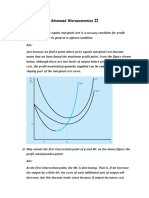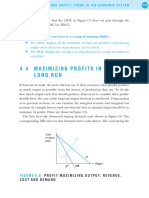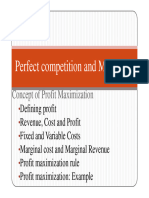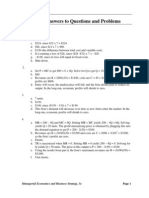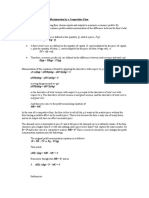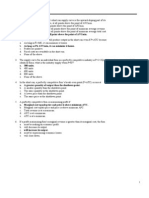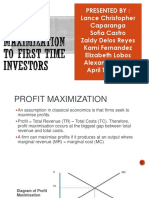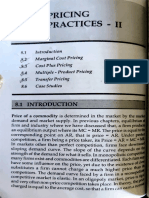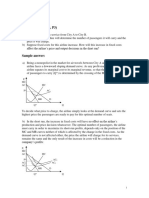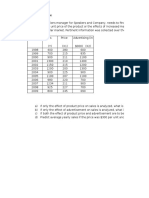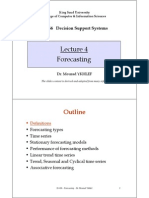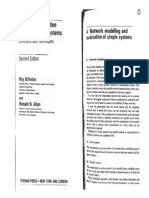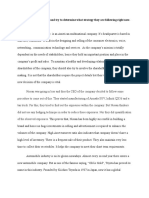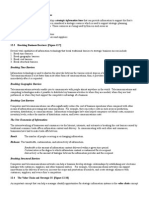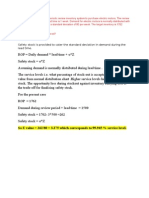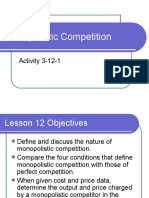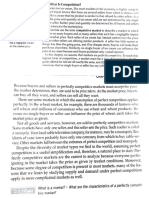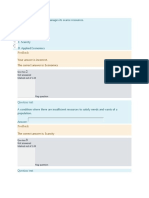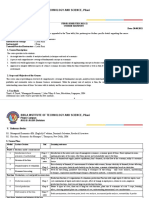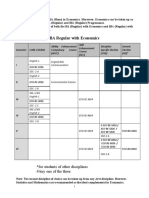Professor Jay Bhattacharya
Spring 2001
Firm Objectives
Profit
Cost minimization: Given a fixed output
level (without any story about how this
output is determined) firms choose the
minimum cost combination of inputs.
Profit maximization: Firms choose that
level of output that yields the highest level
of profits.
Spring 2001
Econ 11--Lecture 13
Profit = Revenue Cost
Last class, we analyzed costs in detail.
The cost minimization problem produces a
function C(Q), which represents minimum
costs given output Q.
Revenue is output multiplied by the price at
which that output sellsR(Q) = PQ.
1
Spring 2001
Profit MaximizationChoosing Output
If a firm produces at all, it will produce an
amount such that MR = MC.
If the extra revenue generated from producing 1
extra unit of output (MR) exceeds the
additional cost of producing that unit, then the
firm can increase its profit by expanding output
by 1 unit.
d dR dC
dR dC
=
=0
=
dQ dQ dQ
dQ dQ
Interpretation: To maximize profits, set
marginal revenue (dR/dQ) equal to marginal
cost (dC/dQ).
Econ 11--Lecture 13
Spring 2001
Second Order Condition
C,R
The SOC is important because of S shaped cost
curves.
Also, if price falls below AVC, the firm (if it
produced positive amounts of output) would earn
a loss. Instead, it should go out of business
Econ 11--Lecture 13
Econ 11--Lecture 13
Econ 11--Lecture 13
Graphical Presentation
d 2 d 2 R d 2C
=
<0
dQ 2 dQ 2 dQ 2
Spring 2001
Supply: How much will firms produce?
max = R(Q) C(Q)
First order condition:
Spring 2001
Econ 11--Lecture 13
slope = P
R=PQ
C(Q)
Q**
5
Spring 2001
R(Q)-C(Q)
Q* Q
Econ 11--Lecture 13
Q**
Q*
Q
6
�Professor Jay Bhattacharya
Spring 2001
Nicholson Example Problem
Lump-Sum Tax
Would a lump-sum profits tax affect the
profit maximizing quantity of output? How
about a proportional tax on profits? How
about a tax assessed on each unit of output?
Profit maximization under a lump-sum
profits tax: (T is the lump-sum tax)
= PQ C ( Q ) T
First order condition is exactly the same:
d dR dC
=
=0
dQ dQ dQ
Spring 2001
Econ 11--Lecture 13
Lump-Sum Tax (continued)
Spring 2001
Under a proportional tax on profits (say, t)
the firms problem is:
= ( PQ C ( Q ) ) (1 t )
R=PQ
The first order condition is:
R=PQ-T
C(Q)
Econ 11--Lecture 13
d dR dC
dR dC
=
=
(1 t ) = 0
dQ dQ dQ
dQ dQ
Q* Q
Spring 2001
Proportional Tax (continued)
Spring 2001
Econ 11--Lecture 13
= PQ (1 t ) C ( Q )
R=PQ(1-t)
Econ 11--Lecture 13
10
Under a tax (say, t) on output the firms
problem is:
R=PQ
C(Q)
Econ 11--Lecture 13
Tax on Output
The firm makes less profits, but the
marginal and limit conditions are the same:
C,R
If the firm
produces positive
Q without the tax,
it produces positive
Q with the tax.
Proportional Tax on Profits
However, it may be optimal for firms to go
out of business if the lump sum tax is high
enough: C,R
Spring 2001
Econ 11--Lecture 13
(1-t)C(Q)
Q* Q
The first order condition is:
d dR
dC
dR
dC
=
(1 t ) = 0 (1 t ) =
dQ dQ
dQ
dQ
dQ
11
Spring 2001
Econ 11--Lecture 13
12
�Professor Jay Bhattacharya
Spring 2001
Tax on Output (continued)
Prices and Industry Structure
The price that firms can charge will depend upon
the structure of the industry.
This tax distorts the firms FOCthe
optimal Q differs from Q*:
In a competitive industry, firms cannot affect prices by
cutting back on (or increasing) output.
In a monopolistic or oligopolistic industry, changes in
output affect market price.
C,R
The firm is more
likely to go out of
business with this
risky tax scheme.
R=PQ
In general, output prices that firm faces will be a
function of the firms output:
C(Q)
P = P(Q)
This is exactly the (inverse) market demand function.
Qnew Q*
Spring 2001
Econ 11--Lecture 13
13
Spring 2001
Econ 11--Lecture 13
14
Supply Curve
Competitive Supply
P
In a competitive industry, firms take prices as
fixed.
If firms charge prices higher than marginal costs, they
lose all their business.
If firms charge prices lower than marginal costs, they
make negative profits.
C(Q )
For price taking firms, dR/dQ = P
The first order condition is P = MC = dC/dQ
The firm will choose output at a point where price is
equal to marginal cost.
Q
Spring 2001
Econ 11--Lecture 13
15
Spring 2001
How Does Supply Vary with
Input Prices
P
For example, an
increase in wages
shifts supply back
since it increases
marginal costs.
Econ 11--Lecture 13
Econ 11--Lecture 13
16
Monopoly Supply
An increase in marginal cost = a shift in the
supply curve
Spring 2001
Econ 11--Lecture 13
17
Monopolists do not sit back and take prices.
They manipulate prices by curtailing output below
competitive levels.
For monopolists, prices are a function of quantity
produced (the inverse market demand curve).
However, like firms in a competitive industry,
monopolists still maximize profits. The FOC is:
dC
dR dP (Q )
Q + P (Q ) =
=
dQ
dQ
dQ
Spring 2001
Econ 11--Lecture 13
18
�Professor Jay Bhattacharya
Spring 2001
Monopoly Supply (Graphical)
Nicholson Example Problem #2
P
dR/dQMarginal
Revenue curve
C(Q )
P(Q) Demand curve
Area in box =
Total revenue
Q(monopoly) Q(competitive)
Spring 2001
Econ 11--Lecture 13
19
Example #2 Solved
Econ 11--Lecture 13
Spring 2001
Inverting two demand functions yields:
1
p1 = q1 + 50
2
21
Spring 2001
max = q 1 q + 50 + q 1 q + 25 (q + q )2
2
1
1
2
1
2
q1 , q2
2
Econ 11--Lecture 13
1
p2 = q2 + 25
4
Econ 11--Lecture 13
22
Example #2 Solution (IV)
Plugging the inverse demand functions back
into the profit function gives the firms
maximization problem in terms of q1 and q2:
Econ 11--Lecture 13
20
The firm chooses q1 and q2 to maximize
profits:
max = q p + q p (q + q )2
1 1
2 2
1
2
q1 , q2
Example #2 Solution (III)
Spring 2001
Econ 11--Lecture 13
Example #2 Solution (continued)
Let q1 be the amount sold in Australia at
price p1.
Let q2 be the amount sold in Lapland at
price p2.
The firms total revenues from the two
locations equal p1q1 + p2q2.
The firms total costs of producing q1 + q2
are 0.25(q1 + q2)2.
Spring 2001
Universal Widget produces high-quality widgets
at its plant in Gulch, Nevada, for sale throughout
the world. The cost function for total widget
production (q) is given by TC = 0.25q2. Widgets
are demanded only in Australia (where demand is
q = 100 2p), and Lapland (where demand is q =
100 4p). If Universal Widget can control q in
each market, how many should it sell in each
location in order to maximize profits? What price
will be charged in each location?
23
The first order conditions for the firms
problem and their solution are:
3
1
q1 q2 + 50 = 0
2
2
1
q1 q2 + 25 = 0
2
Spring 2001
q1 = 30 p1 = 35
q 2 = 10 p2 = 22.5
Econ 11--Lecture 13
24
�Professor Jay Bhattacharya
Spring 2001
Producer Surplus
3 Ways to Measure PS
Producer surplus = Revenue - Variable Cost
Profit = Revenue - Total Cost
Producer surplus = Profit if no fixed costs
or if in the long-run
AKA operating profit
PS = Revenue - Variable Cost
PS = Area where Price > MC
PS = Area to the left of the supply curve
Spring 2001
Spring 2001
Econ 11--Lecture 13
25
Producer Surplus
P
P = C (Q )
The industry supply curve is the horizontal
sum of the existing firms supply curves
Econ 11--Lecture 13
Q1
Q
Econ 11--Lecture 13
26
Industry Supply
Market
price line
Spring 2001
Econ 11--Lecture 13
27
Spring 2001
Q2
Econ 11--Lecture 13
Q1+Q2
Q
28










